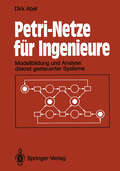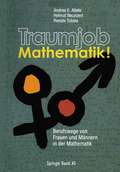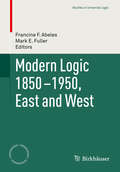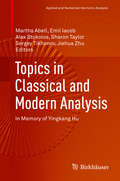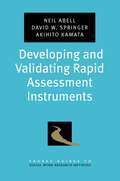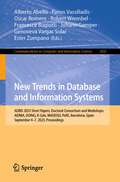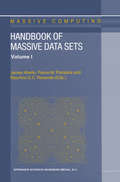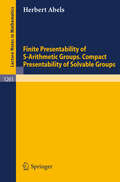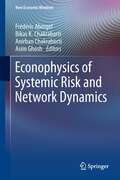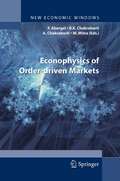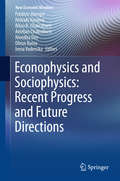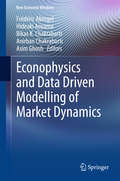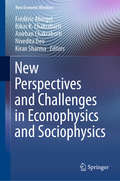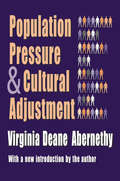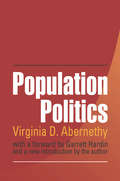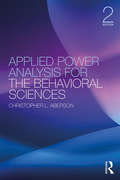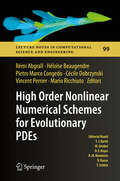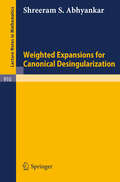- Table View
- List View
Petri-Netze für Ingenieure: Modellbildung und Analyse diskret gesteuerter Systeme
by Dirk AbelDie Analyse diskret gesteuerter Systeme beschränkt sich bisher auf die Möglichkeiten der Simulation; für zeitlich parallele, nebenläufige Prozesse benötigt man als weiteres, leistungsfähiges Instrument die Petri-Netze. Das Buch führt in die Theorie ein, soweit dies für den Anwender erforderlich ist, beschreibt die Möglichkeiten und zeigt die Anwendung sowohl mit Hilfe graphentheoretischer als auch algebraischer Methoden.
Traumjob Mathematik!: Berufswege von Frauen und Männern in der Mathematik
by Andrea E. Abele Helmut Neunzert Renate TobiesDas Buch bietet erstmalig Einsichten in historische und aktuelle Berufsverläufe von Frauen und Männern in der Mathematik. Ziel des Buches ist zu zeigen, dass es sich lohnt, Mathematik zu studieren. Das Buch fasst die Ergebnisse einer von der Volkswagenstiftung geförderten interdisziplinären Studie zusammen, an der Wissenschaftler der Mathematik, der Psychologie und der Mathematikgeschichte beteiligt waren. Das Buch ist wichtig für Abiturienten, Berufsberatungsstellen, Bildungspolitik, Mathematikhistoriker und Berufspsychologen.
Modern Logic 1850-1950, East and West (Studies in Universal Logic)
by Francine F. Abeles Mark E. FullerThis book presents diverse topics in mathematical logic such as proof theory, meta-mathematics, and applications of logic to mathematical structures. The collection spans the first 100 years of modern logic and is dedicated to the memory of Irving Anellis, founder of the journal 'Modern Logic', whose academic work was essential in promoting the algebraic tradition of logic, as represented by Charles Sanders Peirce. Anellis’s association with the Russian logic community introduced their school of logic to a wider audience in the USA, Canada and Western Europe. In addition, the collection takes a historical perspective on proof theory and the development of logic and mathematics in Eastern Logic, the Soviet Union and Russia. The book will be of interest to historians and philosophers in logic and mathematics, and the more specialized papers will also appeal to mathematicians and logicians.
Topics in Classical and Modern Analysis: In Memory of Yingkang Hu (Applied and Numerical Harmonic Analysis)
by Martha Abell Emil Iacob Alex Stokolos Sharon Taylor Sergey Tikhonov Jiehua ZhuDifferent aspects of harmonic analysis, complex analysis, sampling theory, approximation theory and related topics are covered in this volume. The topics included are Fourier analysis, Padè approximation, dynamical systems and difference operators, splines, Christoffel functions, best approximation, discrepancy theory and Jackson-type theorems of approximation. The articles of this collection were originated from the International Conference in Approximation Theory, held in Savannah, GA in 2017, and organized by the editors of this volume.
Developing And Validating Rapid Assessment Instruments
by Neil Abell David W. Springer Akihito KamataNew Trends in Database and Information Systems: ADBIS 2023 Short Papers, Doctoral Consortium and Workshops: AIDMA, DOING, K-Gals, MADEISD, PeRS, Barcelona, Spain, September 4–7, 2023, Proceedings (Communications in Computer and Information Science #1850)
by Alberto Abelló Panos Vassiliadis Oscar Romero Robert Wrembel Francesca Bugiotti Johann Gamper Genoveva Vargas Solar Ester ZumpanoThis book constitutes the refereed proceedings of the Doctoral Consortium and Workshops on New Trends in Database and Information Systems, ADBIS 2023, held in Barcelona, Spain, during September 4–7, 2023.The 29 full papers, 25 short papers and 7 doctoral consortium included in this book were carefully reviewed and selected from 148. They were organized in topical sections as follows: ADBIS Short Papers: Index Management & Data Reconstruction, ADBIS Short Papers: Query Processing, ADBIS Short Papers: Advanced Querying Techniques, ADBIS Short Papers: Fairness in Data Management, ADBIS Short Papers: Data Science, ADBIS Short Papers: Temporal Graph Management, ADBIS Short Papers: Consistent Data Management, ADBIS Short Papers: Data Integration, ADBIS Short Papers: Data Quality, ADBIS Short Papers: Metadata Management, Contributions from ADBIS 2023 Workshops and Doctoral Consortium, AIDMA: 1st Workshop on Advanced AI Techniques for Data Management, Analytics, DOING: 4th Workshop on Intelligent Data - From Data to Knowledge, K-Gals: 2nd Workshop on Knowledge Graphs Analysis on a Large Scale, MADEISD: 5th Workshop on Modern Approaches in Data Engineering, Information System Design, PeRS: 2nd Workshop on Personalization, Recommender Systems, Doctoral Consortium.
Handbook of Massive Data Sets (Massive Computing #4)
by James Abello Panos M. Pardalos Mauricio G. C. ResendeThe proliferation of massive data sets brings with it a series of special computational challenges. This "data avalanche" arises in a wide range of scientific and commercial applications. With advances in computer and information technologies, many of these challenges are beginning to be addressed by diverse inter-disciplinary groups, that indude computer scientists, mathematicians, statisticians and engineers, working in dose cooperation with application domain experts. High profile applications indude astrophysics, bio-technology, demographics, finance, geographi cal information systems, government, medicine, telecommunications, the environment and the internet. John R. Tucker of the Board on Mathe matical Seiences has stated: "My interest in this problern (Massive Data Sets) isthat I see it as the rnost irnportant cross-cutting problern for the rnathernatical sciences in practical problern solving for the next decade, because it is so pervasive. " The Handbook of Massive Data Sets is comprised of articles writ ten by experts on selected topics that deal with some major aspect of massive data sets. It contains chapters on information retrieval both in the internet and in the traditional sense, web crawlers, massive graphs, string processing, data compression, dustering methods, wavelets, op timization, external memory algorithms and data structures, the US national duster project, high performance computing, data warehouses, data cubes, semi-structured data, data squashing, data quality, billing in the large, fraud detection, and data processing in astrophysics, air pollution, biomolecular data, earth observation and the environment.
Finite Presentability of S-Arithmetic Groups. Compact Presentability of Solvable Groups (Lecture Notes in Mathematics #1261)
by Herbert AbelsThe problem of determining which S-arithmetic groups have a finite presentation is solved for arbitrary linear algebraic groups over finite extension fields of #3. For certain solvable topological groups this problem may be reduced to an analogous problem, that of compact presentability. Most of this monograph deals with this question. The necessary background material and the general framework in which the problem arises are given partly in a detailed account, partly in survey form. In the last two chapters the application to S-arithmetic groups is given: here the reader is assumed to have some background in algebraic and arithmetic group. The book will be of interest to readers working on infinite groups, topological groups, and algebraic and arithmetic groups.
Econophysics of Systemic Risk and Network Dynamics (New Economic Windows)
by Édéric Abergel Bikas K. Chakrabarti Anirban Chakraborti Asim GhoshThe primary goal of the book is to present the ideas and research findings of active researchers such as physicists, economists, mathematicians and financial engineers working in the field of “Econophysics,” who have undertaken the task of modeling and analyzing systemic risk, network dynamics and other topics.Of primary interest in these studies is the aspect of systemic risk, which has long been identified as a potential scenario in which financial institutions trigger a dangerous contagion mechanism, spreading from the financial economy to the real economy.This type of risk, long confined to the monetary market, has spread considerably in the recent past, culminating in the subprime crisis of 2008. As such, understanding and controlling systemic risk has become an extremely important societal and economic challenge. The Econophys-Kolkata VI conference proceedings are dedicated to addressing a number of key issues involved. Several leading researchers in these fields report on their recent work and also review contemporary literature on the subject.
Econophysics of Order-driven Markets (New Economic Windows)
by Édéric Abergel Bikas K. Chakrabarti Anirban Chakraborti Manipushpak MitraThe primary goal of the book is to present the ideas and research findings of active researchers from various communities (physicists, economists, mathematicians, financial engineers) working in the field of "Econophysics", who have undertaken the task of modelling and analyzing order-driven markets. Of primary interest in these studies are the mechanisms leading to the statistical regularities ("stylized facts") of price statistics. Results pertaining to other important issues such as market impact, the profitability of trading strategies, or mathematical models for microstructure effects, are also presented. Several leading researchers in these fields report on their recent work and also review the contemporary literature. Some historical perspectives, comments and debates on recent issues in Econophysics research are also included.
Econophysics and Sociophysics: Recent Progress and Future Directions (New Economic Windows)
by Frédéric Abergel Hideaki Aoyama Bikas K. Chakrabarti Anirban Chakraborti Nivedita Deo Dhruv Raina Irena VodenskaThis book presents the proceedings from ECONOPHYS-2015, an international workshop held in New Delhi, India, on the interrelated fields of “econophysics” and “sociophysics”, which have emerged from the application of statistical physics to economics and sociology. Leading researchers from varied communities, including economists, sociologists, financial analysts, mathematicians, physicists, statisticians, and others, report on their recent work, discuss topical issues, and review the relevant contemporary literature. A society can be described as a group of people who inhabit the same geographical or social territory and are mutually involved through their shared participation in different aspects of life. It is possible to observe and characterize average behaviors of members of a society, an example being voting behavior. Moreover, the dynamic nature of interaction within any economic sector comprising numerous cooperatively interacting agents has many features in common with the interacting systems of statistical physics. It is on these bases that interest has grown in the application within sociology and economics of the tools of statistical mechanics. This book will be of value for all with an interest in this flourishing field.
Econophysics and Data Driven Modelling of Market Dynamics (New Economic Windows)
by Frédéric Abergel Hideaki Aoyama Bikas K. Chakrabarti Anirban Chakraborti Asim GhoshThis book presents the works and research findings of physicists, economists, mathematicians, statisticians, and financial engineers who have undertaken data-driven modelling of market dynamics and other empirical studies in the field of Econophysics. During recent decades, the financial market landscape has changed dramatically with the deregulation of markets and the growing complexity of products. The ever-increasing speed and decreasing costs of computational power and networks have led to the emergence of huge databases. The availability of these data should permit the development of models that are better founded empirically, and econophysicists have accordingly been advocating that one should rely primarily on the empirical observations in order to construct models and validate them. The recent turmoil in financial markets and the 2008 crash appear to offer a strong rationale for new models and approaches. The Econophysics community accordingly has an important future role to play in market modelling. The Econophys-Kolkata VIII conference proceedings are devoted to the presentation of many such modelling efforts and address recent developments. A number of leading researchers from across the globe report on their recent work, comment on the latest issues, and review the contemporary literature.
Econophysics of Agent-Based Models (New Economic Windows)
by Frédéric Abergel Hideaki Aoyama Bikas K. Chakrabarti Anirban Chakraborti Asim GhoshThe primary goal of this book is to present the research findings and conclusions of physicists, economists, mathematicians and financial engineers working in the field of "Econophysics" who have undertaken agent-based modelling, comparison with empirical studies and related investigations. Most standard economic models assume the existence of the representative agent, who is “perfectly rational” and applies the utility maximization principle when taking action. One reason for this is the desire to keep models mathematically tractable: no tools are available to economists for solving non-linear models of heterogeneous adaptive agents without explicit optimization. In contrast, multi-agent models, which originated from statistical physics considerations, allow us to go beyond the prototype theories of traditional economics involving the representative agent. This book is based on the Econophys-Kolkata VII Workshop, at which many such modelling efforts were presented. In the book, leading researchers in their fields report on their latest work, consider recent developments and review the contemporary literature.
New Perspectives and Challenges in Econophysics and Sociophysics (New Economic Windows)
by Frédéric Abergel Bikas K. Chakrabarti Anirban Chakraborti Nivedita Deo Kiran SharmaThis book presents the latest perspectives and challenges within the interrelated fields of econophysics and sociophysics, which have emerged from the application of statistical physics to economics and sociology. Economic and financial markets appear to be in a permanent state of flux. Billions of agents interact with each other, giving rise to complex dynamics of economic quantities at the micro and macro levels. With the availability of huge data sets, researchers can address questions at a much more granular level than was previously possible. Fundamental questions regarding the aggregation of actions and information and the coordination, complexity, and evolution of economic and financial networks are currently receiving much attention in the econophysics research agenda. In parallel, the sociophysics literature has focused on large-scale social data and their interrelations. In this book, leading researchers from different communities – economists, sociologists, financial analysts, mathematicians, physicists, statisticians, and others – report on their recent work and their analyses of economic and social behavior.
Deine, meine, unsere Toten: Über die Aushandlung der Deutungshoheit am Lebensende
by Viola AbermetIn der modernen Dienstleistungsgesellschaft werden spezielle wie alltägliche Aufgaben in die Hände von Dienstleistenden übergeben. Gerade im Bereich des Sterbens entsteht die Herausforderung, eine besonders emotionale und sensible Arbeit verrichten zu müssen, in einem der letzten Bereiche, die noch stark mit Familie assoziiert werden. So schließt sich die Frage an, wie dem Übel der Kommodifizierung des Sterbens in der Praxis begegnet wird: Wer darf wie über Tod und Sterben entscheiden? In teilnehmender Beobachtung im Pflegeheim, Hospiz, Bestattungswesen, Friedhof, Krematorium und Palliative Care Team wird der Frage nachgegangen, wie am Lebensende im Beziehungskomplex von Dienstleistenden, Sterbenden und Angehörigen die Deutungshoheit des angemessenen Sterbens ausgehandelt wird. Zu sehen ist ein pragmatisches Spiel mit Elementen der Fürsorge- und Dienstleistungswelten, das ein komplexes und dynamisches Beziehungsgefüge wechselseitiger Dependenzen entstehen lässt.
Population Pressure and Cultural Adjustment
by Virginia Deane AbernethyIntegrating research from anthropology, biology, and history, this provocative, brilliant book proposes a theory of demographic equilibrium. The author's hypothesis is that human beings, like many other species, are able to adjust their population numbers to the carrying capacity of the environment. Abernethy points out that in response to perception of scarcity or abundance of resources, culturally mediated values, beliefs and behavioral patterns are modified in ways that can either raise or lower rates of population growth. Abernethy in this way moves beyond the ideological debates that have sundered the field of policy and population. In real world time and space, cultural adjustments that balance population and resources are made over a long stretch in relatively stable or known environments. These adjustments also operate in processes that involve technological advances that appear to increase carrying capacity, and these usually act to support and underwrite population growth in any given area. In her new introduction to this first paperback edition, Abernethy shows how many of the cultural changes the book predicted in 1979 have come to pass. She details a complex of behaviors that favor single life-styles or small family size that have contributed to low fertility rates among native-born Americans while fertility rates among immigrants continue to climb. Population Pressure and Cultural Adjustment is not simply a theoretical slogan, but discusses a rich set of different cultural situations where this homeostatic process has been disrupted or aborted. Often, disruption occurs after the infusion of foreign value systems as well as new forms of technological innovation, or when highly permeable social boundaries result in the importation of resources for which the limits and consequences are not fully appreciated by the host population. This work will inevitably be controversial because of its implications for the limits as well as the potential of public policy in both advanced and underdeveloped societies.
Population Pressure and Cultural Adjustment
by Virginia Deane AbernethyIntegrating research from anthropology, biology, and history, this provocative, brilliant book proposes a theory of demographic equilibrium. The author's hypothesis is that human beings, like many other species, are able to adjust their population numbers to the carrying capacity of the environment. Abernethy points out that in response to perception of scarcity or abundance of resources, culturally mediated values, beliefs and behavioral patterns are modified in ways that can either raise or lower rates of population growth. Abernethy in this way moves beyond the ideological debates that have sundered the field of policy and population. In real world time and space, cultural adjustments that balance population and resources are made over a long stretch in relatively stable or known environments. These adjustments also operate in processes that involve technological advances that appear to increase carrying capacity, and these usually act to support and underwrite population growth in any given area. In her new introduction to this first paperback edition, Abernethy shows how many of the cultural changes the book predicted in 1979 have come to pass. She details a complex of behaviors that favor single life-styles or small family size that have contributed to low fertility rates among native-born Americans while fertility rates among immigrants continue to climb. Population Pressure and Cultural Adjustment is not simply a theoretical slogan, but discusses a rich set of different cultural situations where this homeostatic process has been disrupted or aborted. Often, disruption occurs after the infusion of foreign value systems as well as new forms of technological innovation, or when highly permeable social boundaries result in the importation of resources for which the limits and consequences are not fully appreciated by the host population. This work will inevitably be controversial because of its implications for the limits as well as the potential of public policy in both advanced and underdeveloped societies.
Population Politics: The Choices That Shape Our Future
by Virginia Abernethy Garrett HardinInternational efforts to regulate fertility rates so that populations do not grow beyond the earth's capacity have included technical assistance and capital; improved health care conditions to lower the risk of infant mortality; increased opportunities to develop literacy; the democratization of governments; and several decades of liberal immigration and refugee policies favoring third world nations. The persistence of high fertility despite international efforts confounds demographers. 'Population Politics' brilliantly dissects the paradigm responsible for the counterproductive efforts of nations and international agencies. Abernethy, a renowned anthropologist, shows why policies hamper the shift to lower fertility. Ireland, Indonesia, Cuba, China, Turkey and Egypt are but a few of the countries Abernethy examines, showing how economic, sociocultural, and agricultural factors that have caused population growth can be harnessed to stabilize population size. 'Population Politics' is a provocative examination of the influence of aid and liberal immigration policies on world population growth, and often counterproductive to the role of the United States as an industrial power. This volume's uniquely interdisciplinary perspective will enlighten the lay reader, as well as demographers and epidemiologists, conservationists, reproduction and family specialists, agricultural economists, and public health personnel. Virginia D. Abernethy is professor emeritus of psychiatry (anthropology) at Vanderbilt Medical School and was for 11 years the editor of the scholarly journal 'Population and Environment. Garrett Hardin is emeritus professor of human ecology in the Department of Biological Sciences and the University of California, Santa Barbara.
Population Politics: The Choices That Shape Our Future
by Virginia Abernethy Garrett HardinInternational efforts to regulate fertility rates so that populations do not grow beyond the earth's capacity have included technical assistance and capital; improved health care conditions to lower the risk of infant mortality; increased opportunities to develop literacy; the democratization of governments; and several decades of liberal immigration and refugee policies favoring third world nations. The persistence of high fertility despite international efforts confounds demographers. 'Population Politics' brilliantly dissects the paradigm responsible for the counterproductive efforts of nations and international agencies. Abernethy, a renowned anthropologist, shows why policies hamper the shift to lower fertility. Ireland, Indonesia, Cuba, China, Turkey and Egypt are but a few of the countries Abernethy examines, showing how economic, sociocultural, and agricultural factors that have caused population growth can be harnessed to stabilize population size. 'Population Politics' is a provocative examination of the influence of aid and liberal immigration policies on world population growth, and often counterproductive to the role of the United States as an industrial power. This volume's uniquely interdisciplinary perspective will enlighten the lay reader, as well as demographers and epidemiologists, conservationists, reproduction and family specialists, agricultural economists, and public health personnel. Virginia D. Abernethy is professor emeritus of psychiatry (anthropology) at Vanderbilt Medical School and was for 11 years the editor of the scholarly journal 'Population and Environment. Garrett Hardin is emeritus professor of human ecology in the Department of Biological Sciences and the University of California, Santa Barbara.
Applied Power Analysis for the Behavioral Sciences: 2nd Edition
by Christopher L. AbersonApplied Power Analysis for the Behavioral Sciences is a practical "how-to" guide to conducting statistical power analyses for psychology and related fields. The book provides a guide to conducting analyses that is appropriate for researchers and students, including those with limited quantitative backgrounds. With practical use in mind, the text provides detailed coverage of topics such as how to estimate expected effect sizes and power analyses for complex designs. The topical coverage of the text, an applied approach, in-depth coverage of popular statistical procedures, and a focus on conducting analyses using R make the text a unique contribution to the power literature. To facilitate application and usability, the text includes ready-to-use R code developed for the text. An accompanying R package called pwr2ppl (available at https://github.com/chrisaberson/pwr2ppl) provides tools for conducting power analyses across each topic covered in the text.
Applied Power Analysis for the Behavioral Sciences: 2nd Edition
by Christopher L. AbersonApplied Power Analysis for the Behavioral Sciences is a practical "how-to" guide to conducting statistical power analyses for psychology and related fields. The book provides a guide to conducting analyses that is appropriate for researchers and students, including those with limited quantitative backgrounds. With practical use in mind, the text provides detailed coverage of topics such as how to estimate expected effect sizes and power analyses for complex designs. The topical coverage of the text, an applied approach, in-depth coverage of popular statistical procedures, and a focus on conducting analyses using R make the text a unique contribution to the power literature. To facilitate application and usability, the text includes ready-to-use R code developed for the text. An accompanying R package called pwr2ppl (available at https://github.com/chrisaberson/pwr2ppl) provides tools for conducting power analyses across each topic covered in the text.
High Order Nonlinear Numerical Schemes for Evolutionary PDEs: Proceedings of the European Workshop HONOM 2013, Bordeaux, France, March 18-22, 2013 (Lecture Notes in Computational Science and Engineering #99)
by Rémi Abgrall Héloïse Beaugendre Pietro Marco Congedo Cécile Dobrzynski Vincent Perrier Mario RicchiutoThis book collects papers presented during the European Workshop on High Order Nonlinear Numerical Methods for Evolutionary PDEs (HONOM 2013) that was held at INRIA Bordeaux Sud-Ouest, Talence, France in March, 2013. The central topic is high order methods for compressible fluid dynamics. In the workshop, and in this proceedings, greater emphasis is placed on the numerical than the theoretical aspects of this scientific field. The range of topics is broad, extending through algorithm design, accuracy, large scale computing, complex geometries, discontinuous Galerkin, finite element methods, Lagrangian hydrodynamics, finite difference methods and applications and uncertainty quantification. These techniques find practical applications in such fields as fluid mechanics, magnetohydrodynamics, nonlinear solid mechanics, and others for which genuinely nonlinear methods are needed.
Resolution of Singularities of Embedded Algebraic Surfaces (Springer Monographs in Mathematics)
by Shreeram S. AbhyankarThe common solutions of a finite number of polynomial equations in a finite number of variables constitute an algebraic variety. The degrees of freedom of a moving point on the variety is the dimension of the variety. A one-dimensional variety is a curve and a two-dimensional variety is a surface. A three-dimensional variety may be called asolid. Most points of a variety are simple points. Singularities are special points, or points of multiplicity greater than one. Points of multiplicity two are double points, points of multiplicity three are tripie points, and so on. A nodal point of a curve is a double point where the curve crosses itself, such as the alpha curve. A cusp is a double point where the curve has a beak. The vertex of a cone provides an example of a surface singularity. A reversible change of variables gives abirational transformation of a variety. Singularities of a variety may be resolved by birational transformations.
